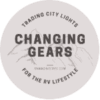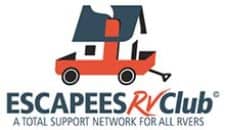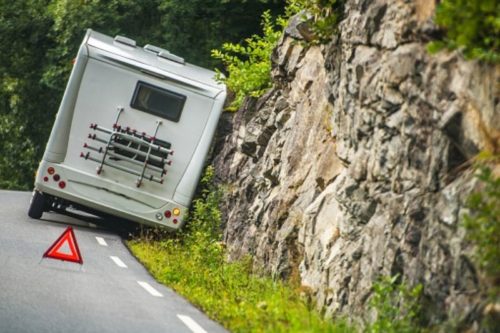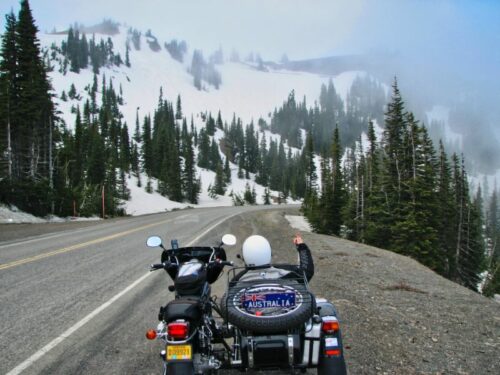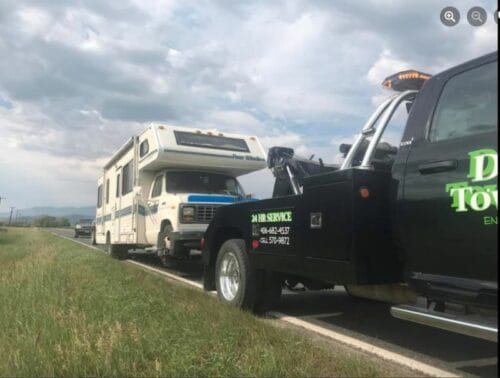As a female living that minimal and adventurous thing we call #vanlife, my first priority is always safety. Whether you’re living in a van, bus, RV, or custom rig, there are many safety factors to consider: weather, theft protection, accidents – even other people!
Let’s go beyond the obvious like a first aid kit and spare tire and talk about some RV and van life essentials that will not only make your life so much easier but will also keep you prepared (Scout’s honor) for anything else you might encounter. Except for an angry grizzly bear. You’re on your own with that one.

23 VANLIFE ESSENTIALS FOR SAFETY ON THE ROAD
1. GPS Tracker
For those of you that enjoy hiking and exploring the great outdoors, I highly recommend investing in a high-quality GPS tracker. This will ensure that you always know where you are and how to get where you’re going next!
Capabilities to look out for are durability, a built-in electronic compass, data storage, Hotfix satellite prediction, battery life, and a dual battery system. The Garmin Montana 680 has all these capabilities in addition to a digital camera and 250,000 preloaded geocaches to explore!
Price: The cost of GPS trackers varies greatly with some starting as low as $99 and capping out around $700.
2. Portable Power Station
Portable power stations offer a plethora of safety essentials all wrapped up in one compact and rechargeable box. They include battery charging and jumpstart capabilities, an air compressor for tires and blow-up mattresses, an LED light, and USB ports to charge electronics.
I recommend the Stanley Fatmax 1000 Peak Amp Power Station because it’s affordable, built for rugged, outdoor life and has a smart stop air compressor feature that takes the hassle out of refilling tires. Just remember to keep your power station charged by utilizing electricity hook-ups along your route.
Price: $89 – $250
3. Propane Alarm
If you’re living solely out of your van, odds are you’re cooking with good ol’ fashioned propane. Propane, while great for cooking, is an odorless gas that can have serious side effects when inhaled. Plus it’s explosive. Whether your stove is built into your van or you cook with a portable camping stove, it’s always a good idea to have a propane detector located inside your van in case of leaks.
When choosing a propane alarm, remember that not all CO2 detectors are built to detect propane and natural gas. Be sure to purchase a propane alarm like Safe T Alert 25 Mini CO/Propane Alarm that alerts users of unsafe levels of CO2 and propane.
Price: $40 – $100
4. Extra Propane Fuel
As a general rule, you should keep some dry food tucked away in your vehicle for emergency situations. But, if your main source of heat for cooking is propane, you might also want to keep an extra 1 lb. bottle of propane handy in case you run out, forget to purchase propane en route, or find yourself stranded for a short period of time.
Price: $5 – $9
5. Spare Engine Oil
Vanlifers in older model Volkswagens and campers are more likely to experience oil leaks and other small maintenance issues. Having an extra quart of oil on hand to replace lost oil can help you get your vehicle to the closest repair shop and prevent any further mechanical damage.
Price: $10 – $30
6. Octane Booster Or Fuel Treatment
Gas stations can be few and far between when it comes to places like the desert and mountains. And the more remote you are, the more the fuel quality decreases. For those situations when you really get out there, it’s a good idea to keep some octane booster nearby in case you encounter low-quality fuel on your route.
Price: $4 – $10
7. Accident Insurance
You can never be too safe on the road, especially when it comes to the actions of other drivers along your route. This is why many vanlifers and campers invest in regular auto insurance as well as additional coverage for the build of your vehicle and your belongings inside.
Depending on the company you choose, additional RV coverage might include total loss replacement, replacement of personal items, emergency expense coverage, and special windshield replacement. Here is a list of some top-rated auto insurance companies that offer accident insurance with RV insurance add-ons for additional coverage:
- Good Sam
- Progressive
- National General
- State Farm
- Liberty Mutual
- GEICO
Price: $250 – $1,500/year depending on level of coverage.
8. Dash Cam
A dash cam can protect you from liability when it comes to on-road and off-road accidents. Having a dashcam makes reporting an incident that much easier and may even hasten the insurance process and speed up your pay-out.
Dash cams can also be an added layer of security when it comes to vandalism, break ins, personal safety, and more.
Price: $30 – $300 depending on quality and capabilities
9. Compact Lockbox
A compact electronic safe or key-entry lockbox is a simple, affordable, discreet way to keep all your valuables safe on the road. These small storage boxes are compact enough to store in your van yet just big enough to hold most jewelry, cash, important documents, and electronics.
For max protection, I recommend purchasing a safe that has similar capabilities to the Honeywell Fire & Waterproof Safe Chest. This lockbox is lightweight, secure, portable, durable, fireproof and waterproof.
Price: $20 – $200 depending on brand, durability, and preference
10. Portable Air Compressor
If you’re not considering a portable power station with air compressor capabilities, you may still want to consider bringing along a portable, rechargeable, 12 V air compressor. Air compressors are clutch on the road not only for refilling vehicle tires but also for pumping up bike tires and blowing up air mattresses and sporting equipment.
Price: $30 – $75
11. Jumper Cables
You never know when you’ll wake up to a dead battery and believe me when I say, it’s not a good feeling! Be sure to keep some jumper cables nearby in case your vehicle battery dies and so that you can help others on the road that might be dealing with the same issue. Some things to keep in mind when choosing a set of jumper cables are cable quality, durability, and length. I recommend springing for the longer jumper cables just in case you find your vehicle in an awkward position when the battery fails.
Price: $14 – $40 depending on quality
12. Multipurpose Tool Kit
Having a multipurpose tool kit stashed away in your vehicle for small maintenance projects and engine repair is essential, especially if you know your way around an engine. This will allow you to make any small repairs on the fly, instead of having your vehicle towed to the nearest shop. If you’re not mechanically inclined, you should make a habit of knowing where the closest shop is and/or subscribe to AAA.
What to include in your tool kit:
- A tire iron
- Tire pressure gauge
- A socket set
- Pliers
- Wire cutters
- Screwdrivers
- An adjustable wrench
- A rubber mallet
- Duct tape
- A tow strap
- Flares
You may also want to include extra:
- Fuses
- Bulbs
- Spark plugs
- Brake fluid
- Zip-ties
Price: $50 – $100
13. Hatchet
Whether or not you purchase pre-cut firewood or scavenge on your own, an ax or hatchet is a good tool to keep around for cutting wood and clearing away brush. An ax or hatchet is especially helpful when cutting wood for warmth and for placing wood under your tires to get unstuck. And, while hopefully unlikely, you can even use this tool as a means to defend yourself from dangerous people on the road.
As a young female, I would recommend an ax/hatchet similar to the Estwing 14in. Campers Ax. This ax is lightweight and compact, has a shock absorbing grip, and comes with a protective sheath to preserve blade quality and prevent accidents.
Price: $15 – $30
14. Windshield Scraper
Safe travel in cold weather begins with good visibility. So, for those trips where you may face extreme cold temperatures, be sure to pack a windshield scraper. Just remember that no matter what windshield scraper you choose, you should always allow your car to warm up and soften the ice before scraping.
Price: $10 – $20
15. Waterproof Dry Bags
Waterproof storage bags come in handy more often than you’d think! Especially if you enjoy hiking, boating, canoeing, surfing, or other water activities. These bags are excellent for keeping valuables, technology, and clothing safe and dry in addition to providing extra organization and housekeeping.
Waterproof storage bags range in size from bags just big enough for your phone up to 45 liters and higher! I recommend picking up a variety-pack of bags so that you have a few different options when you’re on-the-go.
Price: $10 – $50
16. Fire Extinguisher
If you live out of your van full-time, you absolutely need a fire extinguisher. Not only will a fire extinguisher provide extra fire-safety from man-made fires or electrical issues, it may also come in handy for putting out bonfires and campfires when you’re ready to move on. You can order a fire extinguisher like this one online or you can find one at your local camping store, Wal-Mart, Home Depot, Lowes, etc.
Price: $30 – $60
17. Flashlight & Batteries
It might seem obvious that you would need a flashlight when camping or traveling, but we’ll add it to the list for good measure. Flashlights are essential on the road for many reasons including to see, to warn oncoming cars of an accident or issue, and to flash for help. Always remember to bring along extra batteries for your flashlight or, if your flashlight is rechargeable, remember to check the battery often and keep your flashlight fully charged when traveling.
Price: $10 – $25
18. First Aid Kit
For general safety purposes, you should always have a fully stocked first aid kit located in your travel vehicle. When you’re living life on-the-go, you never know what is going to happen. So, the better stocked your first-aid kit is now, the more you will benefit later! General first-aid kits should include at least the following items:
- First-aid manual
- Multi-size adhesive bandages (waterproof)
- Antibacterial wipes or pads
- Gauze
- Adhesive medical grade tape
- Sterile gloves
- Antiseptic
- Aspirin or pain killer
- Antibiotic ointment
- Scissors
- Tweezers
- Breathing barrier or face mask
- Safety pins
- Cold compress
- Emergency Blanket
- Thermometer
Other important first-aid items to include in your kit:
- Antacid
- Antidiarrheal
- Allergy medication
- Cold/flu medication
- Bug spray
- Bug bite ointment
- Sunscreen
- An extra lighter/matches
- List of emergency contacts/prescription/allergies
- Aloe and/or moleskin
- Small knife
- Resealable plastic bags
- Dry food
Price: $10 – $50
19. Waterproof Matches
Is it just me? Or do lighters always die at the most inconvenient time? Because of this, it’s always smart to keep a stash of matches in your van for starting fires in case you run out of butane on-the-go. But, why just keep an extra pack of normal matches when you can be extra prepared with waterproof matches? Waterproof matches stay dry in humid and damp areas and make starting fires in misty and rainy weather a much easier task!
Price: $5 – $10
20. Water Purifier
Access to clean drinking water should be top priority when traveling, no matter the route or destination. There are two easy ways to purify water on the road, depending on your preference. Let’s break down your options:
- Water cleansing tabs: Just throw one of these tabs into your water, wait the designated amount of time, and drink up! For this method, I recommend Aquatabs Water Purification Tabs.
- Screw-on water filter: Just screw this water filter onto your water bottle and drink up! I love my LifeStraw Personal Water Filter.
Price: $7 – $16
21. Safety Whistle
Anytime you leave the safety of your camper vehicle, you should bring along a safety whistle. This is a protective measure you should always take in case you get lost, injured, or stranded and need to alert those in the surrounding area. Safety whistles may also come in handy if you encounter wild animals. Most animals, even larger ones, will scatter upon hearing the high-screech of your whistle.
Conventional whistle signals are:
- One blast = Where are you? (Or response)
- Two blasts = Stop where you are
- Three blasts = I need help! (SOS)
- Four blasts = Come to me
Many safety whistles like the 5-in-1 Coghaland’s Survival Aid Tool and Whistle also have a keychain/lanyard, a dry-storage matchbox, flint, and a compass incorporated right into the whistle.
Price: $4 – $10
22. Pepper Spray/Mace
As a young female living out of my van, personal safety must be my top priority at all times. As an extra protective measure, I always keep a can of pepper spray or mace in my van or on my person when hiking or exploring away from my vehicle.
The key thing to remember here is that you should only keep pepper spray or mace nearby if you know how to use it. Otherwise, you may hurt yourself or others by accident. Be sure to thoroughly read all directions on the packaging or check out this website for a plethora of free tutorial videos about pepper spray.
Price: $10 – $40
23. Emergency Blanket
When traveling to locations with extreme cold weather, be sure to pick up an emergency blanket for safe measure. Emergency blankets are cheap and very useful in extreme weather situations when it comes to staying warm, dry, and sheltered. And the best part is, they pack away as easily and small as a poncho!
Emergency blankets vary greatly when it comes to durability. I recommend investing in an emergency blanket like the S.O.L Emergency Blanket which offers enhanced resistance to snags and tears and comes in a high-visibility color for extra safety.
Price: $5 – $25
At the end of the day, you should take anything you need to keep yourself safe and secure!
* * *
Okay guys, those are the top 20+ items that you absolutely need to keep yourself safe on the road from weather, accidents, theft, and other people. While I left off some basic items, this list has captured everything you need to make sure you have access to food, water, shelter, and more all while on the road.
As individuals, we may require other items to make us feel safe and comfortable living out of our campers. These items might include an extra phone with minutes for emergencies, a knife or gun for enhanced protection, and so on. Just remember that at the end of the day, you should take anything you need to keep yourself safe and secure!
Wishing you guys the best adventures and the safest travel days. Until next time!
Samantha is a college student, turned van-lifer, turned full-time digital nomad! She spent most of 2020 exploring the East Coast in her 1988 Volkwagon Weekender before taking off to explore Latin America. Her work includes everything from virtual assisting to blog writing & she enjoys hostel hopping, meeting new people, and diving head first into different cultures. Samantha has lots of experiences to share about what it’s like to be a young, female, digital nomad in the world today!
-
Samantha Longhttps://changingears.com/author/samantha-long/
-
Samantha Longhttps://changingears.com/author/samantha-long/
-
Samantha Longhttps://changingears.com/author/samantha-long/
